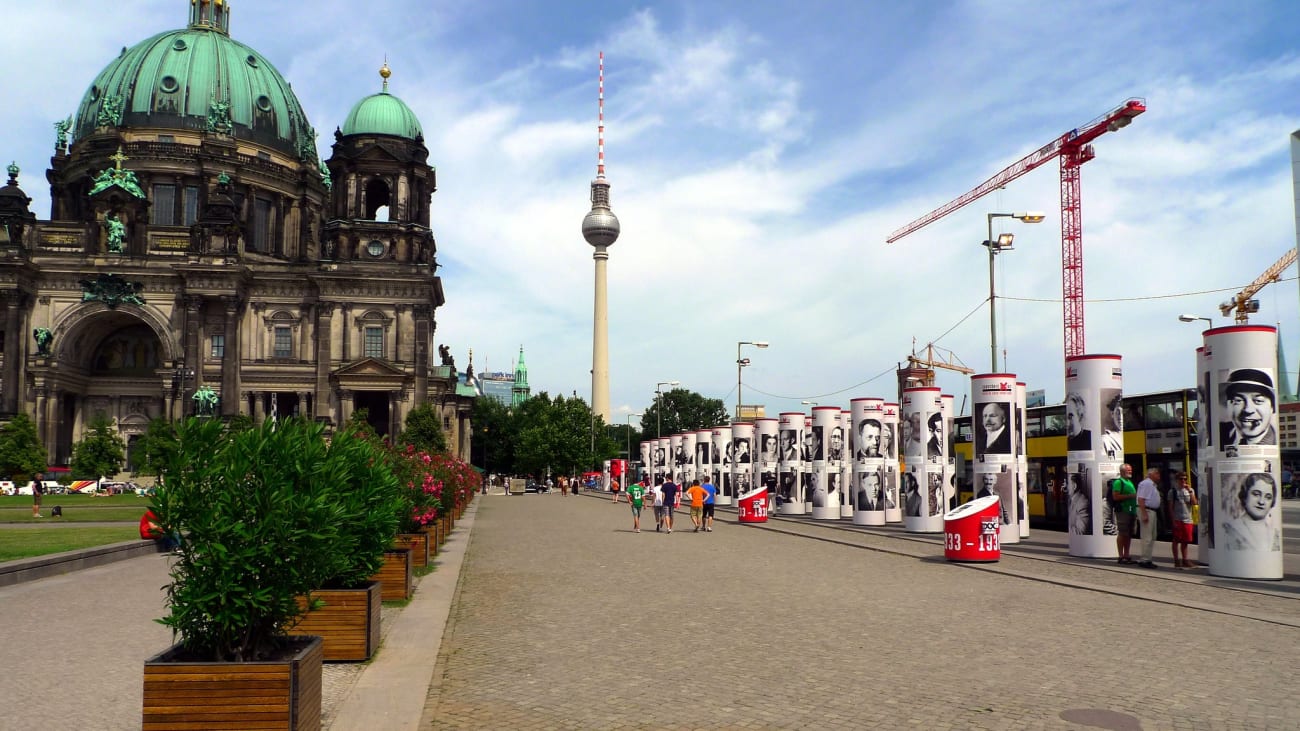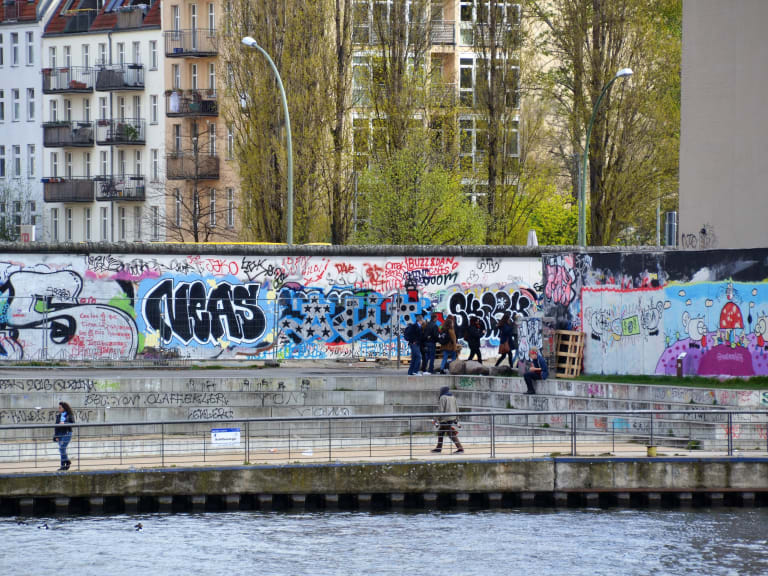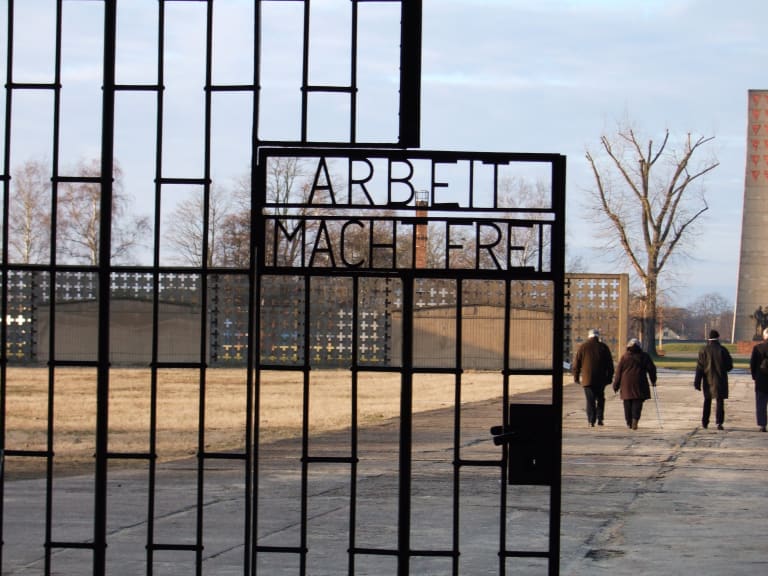Berlin in 5 Days: tips, what to see, and much more
Berlin is an inexhaustible city, but 5 days gives us a good margin to get to know it in some depth. Here's a plan to help you get the most out of it

Berlin | ©Zoetnet
You are visiting Berlin and you have 5 days? At first glance, it may seem like a short time to get to know such a big city with so many attractions. However, if you plan well, it is possible. That's why I've selected the best attractions in the city and organised them into a schedule that will optimise your time to the maximum. You will get to know the city from an urban and artistic point of view, as well as its people. Are you up for it?
Day 1: Brandenburg Gate, Reichstag and Tiergarten

The first day is an introduction to the city. With this guide you will be able to see what you can't miss on your trip to Berlin: the Brandenburg Gate. During this day we will stay in the area bordered to the west by the Tiergarten and to the east and north by the river Spree. This is an area that has everything and which, if well planned, can take up a whole day.
Start at the Brandenburg Gate
Undoubtedly the icon of Berlin and Germany. The Brandenburg Gate is a neoclassical construction designed by the architect Carl Gotthard Langhans. If you book a guided tour of Berlin, this is sure to be your meeting point.
It's certainly not a spectacular monument in its own right (there are much larger and more beautiful ones), but it's hard to beat its iconic importance. Many of Germany's political events of the last century have had this monument as a reference point.
It is also a perfect way to get your first taste of the city. You will be able to take your best photos of Berlin while enjoying a busy and bustling urban area. Once you've taken in the sights, we'll head north towards the river Spree.
Be dazzled by the Reichstag
A 5-minute walk from the Brandenburg Gate is the Reichstag, the centre of Berlin's federal politics. It is an imposing building in the eclectic style typical of the 19th century, but with a very modern glass dome. As you probably know, the Reichstag was badly damaged by a fire in the 1930s, most probably caused by the Nazis.
The modern dome can be visited free of charge. It is open from 08:00 to 24:00, although the last visiting time is at 21:45. Please note that you must register online in order to gain access. You are normally asked for your name and surname, as well as an identification document.
If you decide to visit spontaneously, you may be given an appointment within the next two days. Therefore, my advice is to book a tour of the Reichstag. The whole tour can take around 2 hours.
Eat and relax in the Tiergarten
Right next to the Reichstag is the Tiergarten, one of Berlin's most spectacular parks. A real green lung of the city, it consists of 210 hectares full of paths, gardens of all styles and a lake. I advise you to go there to spend the next 2 or 3 hours. You can eat there, either in one of the restaurants or have a picnic with whatever you have bought.
Afterwards, there is nothing better than taking your lunch down with a pleasant bike tour or, if the weather is nice, lying on the grass. Definitely a great plan if you're visiting Berlin in June, when the weather is the best of the year.
See the Holocaust Memorial

Retracing your steps, a little more than 10 minutes walk from the Brandenburg Gate to the south, you will come across the famous Holocaust Memorial. One of Berlin's most significant memorials to the Jewish genocide during World War II. It is a huge urban sprawl populated by more than 2,000 concrete blocks.
Once you've done that, I suggest you finish the day with a tour of the Third Reich in Berlin which is framed between the Tiergarten, the river Spree to the north and east and along one of the waterways of the same river extending to the south.
Visit Checkpoint Charlie
Checkpoint Charlie, a true testament to the Cold War, is worth a visit.
It is a recreation of the guardhouse located at the exit of the American sector of post-war Berlin. It is, as I said, a recreation, although if you still want to see the original, you can do so at the Allied Museum.
Don't miss Potsdamer Platz
Potsdamer Platz was one of Berlin's most vibrant spaces until World War II.
After the devastation of the bombings, this area has been restored to its former glory and has become one of the symbols of modern Berlin.
Its contemporary buildings, as well as the Sony Center, a large shopping complex, are some of its main attractions.
Dive into Markhaller Neun
If you prefer an immersion in the Berlin of the markets, it is a great idea to start at the Markhalle Neun, located in the same sector we are moving through. It's a historic market that has everything: sausages, meat, fish... and sweets!
If you are travelling with children, don't hesitate to visit the Naschmarkt, a sweet market. It is held every 3 months, so I advise you to check its website to see if it coincides with your visit. And if it's too late for dinner, no problem. You're in an area brimming with shops and restaurants - you won't be short of options!
By the way, if for some reason you don't feel up to a walk, you can always book a sightseeing bus around Berlin. For a very affordable price they will show you everything there is to see in comfort - some of them even include the possibility of a cruise!
Day 2: Museum Island, Alexanderplatz, Berliner Fehrsehturm and Berlin Cathedral

You've already visited the must-see sights yesterday. Therefore, the second day will be dedicated to exploring the city little by little, stopping at the most beautiful places and letting time go by. You'll visit Museum Island and cross the Spree River to the east, in an area dominated by some of the city's most significant urban spaces.
Start the day with culture on Museum Island
There's nothing better than starting your day on Museum Island, a haven of peace and culture in the heart of Berlin. If you're a culture lover, you'll love it. I show you everything you can enjoy in its space:
- Neues Museum: Another museum dedicated to antiquities, but with an interesting collection of Egyptian art. In fact, this is where you will be able to see the famous bust of Nefertiti. It is open between 10:00 and 18:00 hours and tickets are on sale from 12 €.
- Museum Bode: A museum that houses some real marvels such as numismatic collections, medieval artefacts and even objects from the Byzantine Empire. It is also open between 10:00 and 18:00 and you can buy a ticket from 12 €.
These are the museums I recommend you visit. There are others, such as the National Gallery, which, although very interesting, are perhaps best left for another visit to Berlin. The artistic wonders are to be found in the museums I have just mentioned. Bear in mind that they are very large museums and visiting them can take a long time. Regarding tickets, you can get an overview in this article on everything you need to know about Museum Island tickets.
Wander around Alexanderplatz and Berliner Fernsehturm
Once you've had your dose of art, I advise you to round off the morning with a bit of wandering. The best thing to do is to head east and cross the river towards Alexanderplatz and the Berliner Fernsehturm, the TV Tower.
Alexanderplatz is an urban space that during the 19th and part of the 20th century was one of the most important places in the capital's history. After the Second World War it was completely destroyed, so today it is populated by modern monuments.
The Berliner Fernsehturm stands out among them, although it is not on the square itself, but very close by. You can book tickets to the Berlin TV Tower from €28. If your visit to the Museum Island has been short and you arrive around lunchtime, you can eat at its restaurant. At the Sphere Restaurant, you can enjoy great views of Berlin, although I advise you to book in advance.
Visit the Berlin Cathedral

If you still have a few hours to spare before dinner, you can't leave without seeing the nearby Berlin Cathedral: a colossal 19th-century eclectic monument that is probably one of the largest Lutheran churches in Europe.
You can visit it between 9am and 8pm. Don't miss the Crypt of the Hohenzollerns, the Prussian dynasty par excellence, the architect of modern Germany. Admission is available from 7 €. Is there a better way to end the day?
Day 3: Kreuzberg and Berlin nightlife

So far you have explored the more "German" Berlin, the one that shows Germany's historical and cultural heritage. On this third day you will get to know the more modern Berlin, the one that reflects the country's history of the last decades. Or in other words: the multicultural and cosmopolitan Germany. Finish the day with a night-time itinerary to enjoy the legendary nightlife of the German capital.
Immerse yourself in the Kreuzberg district and its alternative atmosphere
Kreuzberg started out as a working-class neighbourhood which, over time, became home to the numerous Turkish immigrants who arrived in Germany in the second half of the 20th century. Today it is a totally multicultural and very alternative neighbourhood whose street life is more than intense.
There are many attractions to enjoy, but you can't miss the Turkish market. It takes place on Tuesdays and Thursdays and is an unbeatable opportunity to try Turkish specialities such as falafel. But you'll also find fresh produce on sale at the many food stalls. If you visit Kreuzberg on any other day, you can replace the Turkish market with one of the many kebab shops. A 100% authentic immersion.
You can complement your visit with a visit to the Köpi squatters' cultural centre, one of the pioneers of the squatters' movement in the 1980s, which today survives as an alternative cultural centre, with exhibitions and even live punk concerts. Anyway, if you want more ideas, here's an article on Things to Do in Kreuzberg.
Take a break on the Landwehrkanal
After lunch, you can take a break at the Landwehrkanal, a 10 km long canal along the Spree River. Once you've regained your strength, I recommend you book a tour of Berlin's Jewish quarter and pay a visit to the Berlin Jewish Museum. Its building, designed by Daniel Libeskind, is one of Berlin's emblematic buildings.
Its exterior is also known as the Exile Garden. Here you can see 49 concrete pillars in homage to the founding of the State of Israel. This museum, considered to be **one of the largest Jewish museums in Europe **, houses documents and objects related to the history of German Jews over the last few centuries. It also has an archive and library. It's open from 10am to 7pm and tickets start at €8.
After your visit, it's time to find a place to dine and recharge your batteries for what's in store: a good night out in Berlin.
Experience Berlin's party scene
You have three options. The first option is advisable if you've really enjoyed the atmosphere in Kreuzberg or you're not 100% ready to move to other areas of Berlin. Since Kreuzberg is a very dynamic neighbourhood , you won't be short of party options. It is also home to some of the city's most famous clubs. Here are some of the most famous places:
- Watergate: Especially recommended if you are an electronic music lover.
- Wild At Heart: A place for rockers.
- Rautschgold: Ideal for the eighties and those looking for a gay atmosphere.
The second option I mentioned above is to go all out and visit some of the busiest and most famous venues in the city. If this is your intention, take note of the most recommended venues:
- Berghain: One of the temples of electronic music with a strong gay and sexually diverse atmosphere. It is located in the Fredrichshain area.
- Tresor: A return to the origins for techno lovers, as it was one of the first nightclubs to specialise in this style of music. It is located in the Mitte area (the most central part of Berlin).
- House of Weekend: A recommended place if you want to party but in moderation. In this venue, located near Alexandeplatz, you can enjoy quiet moments on its terrace with great views of the city.
And another of my favourites: book a beer tour of Berlin. Here's more information on what to do in Berlin at night. Whatever you do, it's going to be intense - tomorrow is another day!
Day 4: A day at leisure with a visit to the Berlin Wall

Good morning, hungover? That's OK, it's foreseen. You're on day four and you've seen quite a bit of Berlin. The basics, so to speak. But one of the most important is missing: the Berlin Wall. However, you can sleep on, you're going to devote the afternoon to it. But if you feel like getting out of bed, we can look for a place to eat.
See the East Gallery of the Berlin Wall
As you know, the Berlin Wall was built in the 1960s on the initiative of the communist government, largely to prevent the flow of citizens from East Berlin to West Berlin. Originally, the installations consisted of the wall itself and additional walls and barbed-wire fencing. Today, sections of the wall are still standing and can be visited on a pleasant walk.
I recommend you book a tour of East Berlin and visit the East Gallery, where you can see some of the best-known graffiti. For example, the famous mural of the passionate kiss between Brezhnev and Honecker, the president of the German Democratic Republic.
There are two ways to visit the East Gallery. One, in the form of a pleasant stroll to where you feel like it, and the other by taking one of the many guided tours, both on foot and by bicycle, which will take you into the history of this building and what the painful separation between Berliners (and Germans) meant for almost 40 years. For more information, here's an article on the best guided tours of Berlin.
Complement your visit to the Berlin Wall with a visit to the museums
If you're interested in history or want to learn more about the evolution of the two Cold War blocs, there's nothing better than booking tickets for the Berlin Wall Museum, a place where you can delve into the history of East and West Berlin, as well as the vicissitudes of its fall or the events that took place there (for example, Kennedy's famous speech).
It is organised in a very didactic way in 13 thematic rooms. You can visit it from €11 between 10am and 7pm.
Eat some typical German food
If you want to try some typical German food, you can go to Restaurant Maximilians, located on Friedrichstrasse, right in the centre and not far from Checkpoint Charlie. The focus of this restaurant is Bavarian food: Bavarian culture is not exactly Berlin culture... but it is definitely 100% German! You'll see it in the furnishings and decor, but also in the Bavarian attire of the staff.
A real paradise for sausages, but they also serve burgers and all kinds of meats. You can also take advantage of the menu of the day, which is served between 11.30am and 2pm. The best thing is that it's not too expensive, as you can eat from €10.
Another option to get a taste of Berlin's culinary culture is to book a food tour of Berlin.
Finish the day shopping
It's been a busy day, so why not relax with a bit of shopping? Just a 15-minute walk from the Wal Museum is the East Side Mall, a shopping centre where you can browse the shops or just go shopping.
And if you're still feeling up to it, you can take a stroll around the area, which used to be part of East Berlin. For a long time, this part of the city was considered the least interesting. Recently, however, it has been revalued as a tourist attraction. If you like history, you'll enjoy the traces of it in the homogeneous architecture so characteristic of the communist bloc in the Cold War.
Dine on local and sustainable food
As you probably already know, Germany is a pioneer in environmentalism and sustainability; in fact, it is nowadays one of the main European consumers of organic products.
This environmental concern has led to the emergence of farm-to-table restaurants in Berlin. If you want to make the most of these spaces, I recommend you eat at Lokal. In addition to the sustainable and ecological food, you can also enjoy the space, decorated with furniture and objects made from wood from Berlin's nearby forests.
Lokal is open from 5pm to midnight, although if you want to dine in, it's best to book in advance. The prices, I won't deceive you, are not cheap, though by no means outrageous. You can eat from 20 € or 30 €. Plus, its central location in Mitte means you're likely to be passing through on your way back to the hotel.
Day 5: Get away from it all and end the day with a visit to a special neighbourhood

It's your fifth day in Berlin, you've already seen the essentials in some depth, so why not take a trip somewhere interesting in Berlin? That's all there is to it. Use your last day to take a break from the German capital.
Take a trip to the Sachsenhausen concentration camp
I advise you to book an excursion to Sachsenhausen. It is located just 50 minutes by car from the city, so you can visit it in just a few hours. It is, as its name suggests, a concentration camp, not an extermination camp, although what you will see there will also leave you impressed. It basically consists of barracks, punishment cells and infirmary facilities. Some 60,000 inmates passed through it, although its history did not end with the end of the Second World War, as it was later used by the Soviets.
Admission is free, although if you want an audio guide (which I recommend), you can buy them for €3. To make the most of your visit, I recommend that you define the best way to get to Sachsenhausen. Here is all the information you will need on how to get to Berlin from Sachsenhausen.
To estimate the time it will take you, consider that on average it takes 3 hours to visit Sachsenhausen. Add to that a little over an hour and a half each way. If you leave in the morning, you'll still have time to enjoy more of Berlin in the afternoon. Sachsenhausen is open from 8.30am to 6pm, so if you go early, you'll have the whole afternoon to yourself.
Finish the day by seeing a Berlin neighbourhood
You have practically the whole afternoon to complement your visit to Berlin with a neighbourhood that you haven't been able to explore so far, because Berlin is huge! I suggest two neighbourhoods, each with its own unique attractions. It's up to you to choose the one that interests you most.
- Charlottenburg: An area with a lot of eighteenth-century charm, as it was developed during the heyday of the Prussian kings. Charlottenburg Palace is a good example of this history. Here you have all the information about how to visit Charlottenburg Palace.
- The Jewish Quarter: Located north of Alexanderplatz, it is of great interest especially for its Jewish Cemetery and the New Synagogue. Do you want more information? In this guide on what to see and do in Berlin's Jewish Quarter you will find all the information you need.
And your exploration of Berlin is almost over. Only 5 days, but it's been a long one. As always, you'll still have a few things left to discover or a street to explore. That's why we're sure you'll want to come back.
Is the five-day Berlin Pass worth it?

The million dollar question. The Berlin Pass is specially designed for visits of 2 or more days in Berlin to enjoy all there is to see and do in Berlin. The Berlin Pass is particularly suitable for those planning an intensive exploration of the city, with many visits to museums and other paid sites. It also includes all the transport you can use for 2 or 3 days (the two types of pass that exist) by metro, tram and bus. Even a boat cruise.
So it all depends on what you want to do. If your idea is to spend every day visiting places that require a ticket, then I recommend it: up to 60 places are included in the Berlin Pass. However, if your idea is to dedicate 1 day to culture, it might not be worth it. Especially since a 2-day Berlin Pass can be bought from €100 and a 3-day pass from €130. So it' s not cheap.
My advice is to do your planning first and then do the maths. To help you do that, let me share with you this article on everything you need to know about the Berlin Pass.
